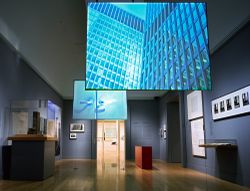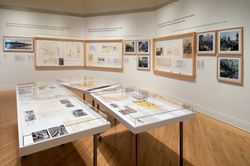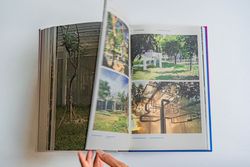L'enseignement de… São Paulo
Angelo Bucci, architecte et professeur à l’Université de São Paulo au Brésil, aborde les questions de la violence et de l’environnement en évolution à São Paulo, en quête de nouvelles formes urbaines. À São Paulo, la violence peut être vue comme gâchant l’expérience de la ville et, par conséquent, sapant la raison d’être du travail de l’architecte. La conférence porte sur(...)
22 avril 2010
L'enseignement de… São Paulo
Actions:
Description:
Angelo Bucci, architecte et professeur à l’Université de São Paulo au Brésil, aborde les questions de la violence et de l’environnement en évolution à São Paulo, en quête de nouvelles formes urbaines. À São Paulo, la violence peut être vue comme gâchant l’expérience de la ville et, par conséquent, sapant la raison d’être du travail de l’architecte. La conférence porte sur(...)
L’exposition témoigne de l’œuvre maîtresse de Cormier, l’Université de Montréal, construite sur le versant nord-ouest du mont Royal entre 1928 et 1943. Elle permet de situer l’architecte montréalais ainsi que son œuvre dans un courant international de pensée où convergent les influences nord-américaines et européennes. Les documents qu’on y présente proviennent en grande(...)
Salles principales
2 mai 1990 au 21 octobre 1990
Ernest Cormier et l'Université de Montréal
Actions:
Description:
L’exposition témoigne de l’œuvre maîtresse de Cormier, l’Université de Montréal, construite sur le versant nord-ouest du mont Royal entre 1928 et 1943. Elle permet de situer l’architecte montréalais ainsi que son œuvre dans un courant international de pensée où convergent les influences nord-américaines et européennes. Les documents qu’on y présente proviennent en grande(...)
Salles principales
Série(s)
AP193.S2
Description:
Series 2, I’ve heard about and Hypnosis chamber, 2004-2006, relates to the conception of the urban structure “I’ve heard about”. The records contain algorithmically-generated images, renderings, pictures of models and exhibitions. There are also photographs of the contour crafting process, 3D models and animated renderings illustrating the construction process of the structure. The project is a conceptual, unbuilt project that is meant to be a habitable organism, an adaptive landscape in a constant state of evolution. By means of transitory scenarios in which the operational mode is entropy and uncertainty, it develops open algorithms based on growth scripts permeable not only to human expressions, but also to the most discrete data such as the chemical emissions (for example due to stress or anxiety) of those who inhabit it. The chemical information is harvested through nanoreceptors feeding the VIAB machine with information. This biostructure becomes the visible part of human contingencies and their negotiation in real time. The structure is conceptualized to be in constant construction through the VIAB machine which is also a constituent of the structure itself. It secretes fiber cement, shaping the landscape where it is located and through which it moves. It generates the reticular structure using a process modelled on contour crafting. The VIAB machine was developed with Robotics Research Lab of the University of Southern California and takes its name from the terms viability and variability. R&Sie(n) considers that due to its mode of emergence “I’ve heard about” fabrication is not subjugated to any political power. Hypnosis chamber is a component of “I’ve heard about”. It consists of an indoor chamber, which was realized as a full-scale sample constructed through automated machinery. The chamber is situated as a part of the whole urban structure presented by “I’ve heard about,” and its goal is to immerse the audience into the project, into a fictional environment only reachable by hypnosis. In this context, hypnosis is a way to help citizens escape from their social condition and experience the new condition of citizenship imagined in “I’ve heard about”, where democracy is re-evaluated as a process of self-determination. Both parts of the projects were shown in contemporary art museums. First at Musée d’art de la ville de Paris in Paris (2005), the Hypnotic chamber is permanently on view at Towada Art Center in Towanda, Japan. AP193.S4 contains a video orienting the project into François Roche theoretical stance, research as speculation, that can be summarize as the use of technological tools to take a critical and political position through esthetic in order to open new lines of thoughts. AP193.S4 contains an updated version of the VIAB machine
2004-2006
I’ve heard about and Hypnosis chamber
Actions:
AP193.S2
Description:
Series 2, I’ve heard about and Hypnosis chamber, 2004-2006, relates to the conception of the urban structure “I’ve heard about”. The records contain algorithmically-generated images, renderings, pictures of models and exhibitions. There are also photographs of the contour crafting process, 3D models and animated renderings illustrating the construction process of the structure. The project is a conceptual, unbuilt project that is meant to be a habitable organism, an adaptive landscape in a constant state of evolution. By means of transitory scenarios in which the operational mode is entropy and uncertainty, it develops open algorithms based on growth scripts permeable not only to human expressions, but also to the most discrete data such as the chemical emissions (for example due to stress or anxiety) of those who inhabit it. The chemical information is harvested through nanoreceptors feeding the VIAB machine with information. This biostructure becomes the visible part of human contingencies and their negotiation in real time. The structure is conceptualized to be in constant construction through the VIAB machine which is also a constituent of the structure itself. It secretes fiber cement, shaping the landscape where it is located and through which it moves. It generates the reticular structure using a process modelled on contour crafting. The VIAB machine was developed with Robotics Research Lab of the University of Southern California and takes its name from the terms viability and variability. R&Sie(n) considers that due to its mode of emergence “I’ve heard about” fabrication is not subjugated to any political power. Hypnosis chamber is a component of “I’ve heard about”. It consists of an indoor chamber, which was realized as a full-scale sample constructed through automated machinery. The chamber is situated as a part of the whole urban structure presented by “I’ve heard about,” and its goal is to immerse the audience into the project, into a fictional environment only reachable by hypnosis. In this context, hypnosis is a way to help citizens escape from their social condition and experience the new condition of citizenship imagined in “I’ve heard about”, where democracy is re-evaluated as a process of self-determination. Both parts of the projects were shown in contemporary art museums. First at Musée d’art de la ville de Paris in Paris (2005), the Hypnotic chamber is permanently on view at Towada Art Center in Towanda, Japan. AP193.S4 contains a video orienting the project into François Roche theoretical stance, research as speculation, that can be summarize as the use of technological tools to take a critical and political position through esthetic in order to open new lines of thoughts. AP193.S4 contains an updated version of the VIAB machine
Series
2004-2006
Projet
AP198.S1.1997.PR02
Description:
Project records document the design process for OCEAN North’s competition entry for the Jyväskylä Music and Arts Centre in 1997. The project was titled Terra Cultura by OCEAN North. The international competition called to create a multi-usage space that would include a venue for the symphonic orchestra, a music school, exhibition spaces, and the possibility to host a variety of small cultural events in the Finnish city of Jyväskylä. The proposed site is in the center of the town, across the street from the Jyväskylä city church and its park, and nearby buildings designed by Alvar Aalto. OCEAN North’s concept presents a topological surface as an extension of the surrounding urban scape with two masses that would host the formal functions of the building (concert hall, music school, exhibition halls). The two volumes, or raised blocks, are divided along a diagonal elevated space, which is the extension of the ground’s topological surface filled and dubbed “Liquid Flow Space” by the design team. In their interview with Greg Lynn, Johan Bettum and Kivi Sotamaa mentioned that the idea for Jyväskylä was that it was a cloud. Digital files, in particular, show the process to achieve the projected design. Drawings provide views of streamed particles and of resulting peels. They also include plans, elevations and axonometric views of the structure. Most files are raster or vector images, likely saved from CAD software. A few files are in CAD formats such as Microstation, 3D Studio and form*Z. Digital files also present sine wave analysis and resulting charts for each component of the program. The analysis and charts present the relationships between various components of the building’s program such as the Art Museum, the Concert Halls, the technical space, and the Common facilities. These files are raster images and spreadsheets. Photographs of the site in Jyväskylä and of models built by OCEAN North were digitized and are included with the digital working files. Physical drawings are chiefly floor plans for the building, but also include sections and sketches. Finally, project files include photographic prints of two built models. One of these models, a small model of the conceptual masses of the building structure, is itself in the archive. Photographs show the model in the context of a city scape model. The second model, not part of the archive at CCA, was built at a bigger scale and was an intricate cardboard and wooden stick structure. Sources: Softspace: from a representation of form to a simulation of space, Edited by Sean Lally and Jessica Young. London, New York: Routledge, 2007. Greg Lynn, ed. Archaeology of the Digital 17: OCEAN North, Jyväskylä Music and Arts Centre, Montréal: Canadian Centre for Architecture, 2017. ePub.
1997
Terra Cultura – Jyväskylä Music and Arts Centre, international competition entry
Actions:
AP198.S1.1997.PR02
Description:
Project records document the design process for OCEAN North’s competition entry for the Jyväskylä Music and Arts Centre in 1997. The project was titled Terra Cultura by OCEAN North. The international competition called to create a multi-usage space that would include a venue for the symphonic orchestra, a music school, exhibition spaces, and the possibility to host a variety of small cultural events in the Finnish city of Jyväskylä. The proposed site is in the center of the town, across the street from the Jyväskylä city church and its park, and nearby buildings designed by Alvar Aalto. OCEAN North’s concept presents a topological surface as an extension of the surrounding urban scape with two masses that would host the formal functions of the building (concert hall, music school, exhibition halls). The two volumes, or raised blocks, are divided along a diagonal elevated space, which is the extension of the ground’s topological surface filled and dubbed “Liquid Flow Space” by the design team. In their interview with Greg Lynn, Johan Bettum and Kivi Sotamaa mentioned that the idea for Jyväskylä was that it was a cloud. Digital files, in particular, show the process to achieve the projected design. Drawings provide views of streamed particles and of resulting peels. They also include plans, elevations and axonometric views of the structure. Most files are raster or vector images, likely saved from CAD software. A few files are in CAD formats such as Microstation, 3D Studio and form*Z. Digital files also present sine wave analysis and resulting charts for each component of the program. The analysis and charts present the relationships between various components of the building’s program such as the Art Museum, the Concert Halls, the technical space, and the Common facilities. These files are raster images and spreadsheets. Photographs of the site in Jyväskylä and of models built by OCEAN North were digitized and are included with the digital working files. Physical drawings are chiefly floor plans for the building, but also include sections and sketches. Finally, project files include photographic prints of two built models. One of these models, a small model of the conceptual masses of the building structure, is itself in the archive. Photographs show the model in the context of a city scape model. The second model, not part of the archive at CCA, was built at a bigger scale and was an intricate cardboard and wooden stick structure. Sources: Softspace: from a representation of form to a simulation of space, Edited by Sean Lally and Jessica Young. London, New York: Routledge, 2007. Greg Lynn, ed. Archaeology of the Digital 17: OCEAN North, Jyväskylä Music and Arts Centre, Montréal: Canadian Centre for Architecture, 2017. ePub.
Project
1997
archives
Niveau de description archivistique:
Collection
CD033
Résumé:
The Aldo Cibic Microrealities project collection primarily consists of presentation materials, publications and born digital materials, like videos and photographs, by Aldo Cibic produced between 2003 and 2008 for the project “Microrealities”.
2003-2008
Collection d’Aldo Cibic pour le projet Microrealities
Actions:
CD033
Résumé:
The Aldo Cibic Microrealities project collection primarily consists of presentation materials, publications and born digital materials, like videos and photographs, by Aldo Cibic produced between 2003 and 2008 for the project “Microrealities”.
archives
Niveau de description archivistique:
collection
2003-2008
Mies en Amérique
Grand penseur et artiste minutieux, et l’un des plus illustres architectes de l’histoire, Ludwig Mies van der Rohe est déjà une figure dominante de sa profession en Allemagne, lorsque, en 1938, dans la cinquantaine, il émigre aux États-Unis. Transplanté de l’école du Bauhaus (dont il a été le dernier directeur) à un institut technique de Chicago, délaissant le milieu de(...)
Salles principales
17 octobre 2001 au 20 janvier 2002
Mies en Amérique
Actions:
Description:
Grand penseur et artiste minutieux, et l’un des plus illustres architectes de l’histoire, Ludwig Mies van der Rohe est déjà une figure dominante de sa profession en Allemagne, lorsque, en 1938, dans la cinquantaine, il émigre aux États-Unis. Transplanté de l’école du Bauhaus (dont il a été le dernier directeur) à un institut technique de Chicago, délaissant le milieu de(...)
Salles principales
Cette exposition illustre la vision originale de Cornelia Hahn Oberlander, qui conçoit son art avec une conscience sociale et un souci de développement écologique durable au Canada. L’exposition met en lumière une sélection de projets de Cornelia Hahn Oberlander, qui ont été réalisés à Ottawa, à Toronto, à Vancouver, à Yellowknife et à Berlin, au cours d’une période(...)
Salle octogonale
11 mai 2006 au 30 juillet 2006
Cornelia Hahn Oberlander : paysages écologiques
Actions:
Description:
Cette exposition illustre la vision originale de Cornelia Hahn Oberlander, qui conçoit son art avec une conscience sociale et un souci de développement écologique durable au Canada. L’exposition met en lumière une sélection de projets de Cornelia Hahn Oberlander, qui ont été réalisés à Ottawa, à Toronto, à Vancouver, à Yellowknife et à Berlin, au cours d’une période(...)
Salle octogonale
ARCH2344
Description:
Film intitulé "E.C. Camp" E.C. représente les initiales de Ernest Cormier. Contexte des séquences indéterminé.
ca. 1930
Négatifs originaux 16mm pour le film intitulé "E.C. Camp"
Actions:
ARCH2344
Description:
Film intitulé "E.C. Camp" E.C. représente les initiales de Ernest Cormier. Contexte des séquences indéterminé.
ca. 1930
documents textuels
ARCH267991
Description:
Documents concern the following buildings in Chandigarh: the animal house and workshop at the Institute for Medical Research, the Institute for Medical Research (Sector 12), Saroop Krishan's house (Sector 8), various schools (nursery, primary and secondary), the Chandigarh Club, low-cost homes, and small office buildings. Texts also consider Pierre Jeanneret's furniture designs. Also includes: - "Social Sciences Research Journal," volume 4, number 2 (July 1979) concerning Chandigarh, India. - "An architect's plea to resolve the problems / of human settlement in South Asia / A design of composite organisation to prepare typical plans of hierarchy of human settlements in India and other parts of Suth [sic] Asia" by Jeet Malhotra, prepared for a symposium on human settlements with special reference to rural settlements in South Asia (March 18-21, 1976). - "A brief note on the conceptual man-made / environmental grid plan for Punjab / to avoid pollution of air, land, water / etc. - a preventative strategy" by Jeet Malhotra (n.d.). - "Architecture 2000 A.D. - Indian Context" by Jeet Malhotra, possibly prepared for the national convention of the Council of Architecture, New Delhi, which took place February 22-23, 1985.
Writings by Jeet Malhotra, predominantly pertaining to Chandigarh, with some concerning Talwara and Punjab, India
Actions:
ARCH267991
Description:
Documents concern the following buildings in Chandigarh: the animal house and workshop at the Institute for Medical Research, the Institute for Medical Research (Sector 12), Saroop Krishan's house (Sector 8), various schools (nursery, primary and secondary), the Chandigarh Club, low-cost homes, and small office buildings. Texts also consider Pierre Jeanneret's furniture designs. Also includes: - "Social Sciences Research Journal," volume 4, number 2 (July 1979) concerning Chandigarh, India. - "An architect's plea to resolve the problems / of human settlement in South Asia / A design of composite organisation to prepare typical plans of hierarchy of human settlements in India and other parts of Suth [sic] Asia" by Jeet Malhotra, prepared for a symposium on human settlements with special reference to rural settlements in South Asia (March 18-21, 1976). - "A brief note on the conceptual man-made / environmental grid plan for Punjab / to avoid pollution of air, land, water / etc. - a preventative strategy" by Jeet Malhotra (n.d.). - "Architecture 2000 A.D. - Indian Context" by Jeet Malhotra, possibly prepared for the national convention of the Council of Architecture, New Delhi, which took place February 22-23, 1985.
documents textuels
Dans le contexte du rechauffement climatique, Philippe Rahm Architectes propose de réinitialiser la discipline architecturale sur ses qualités atmosphériques intrinsèques.
Maison Shaughnessy
29 novembre 2023, 18h
Philippe Rahm : Architecture climatique
Actions:
Description:
Dans le contexte du rechauffement climatique, Philippe Rahm Architectes propose de réinitialiser la discipline architecturale sur ses qualités atmosphériques intrinsèques.
Maison Shaughnessy




